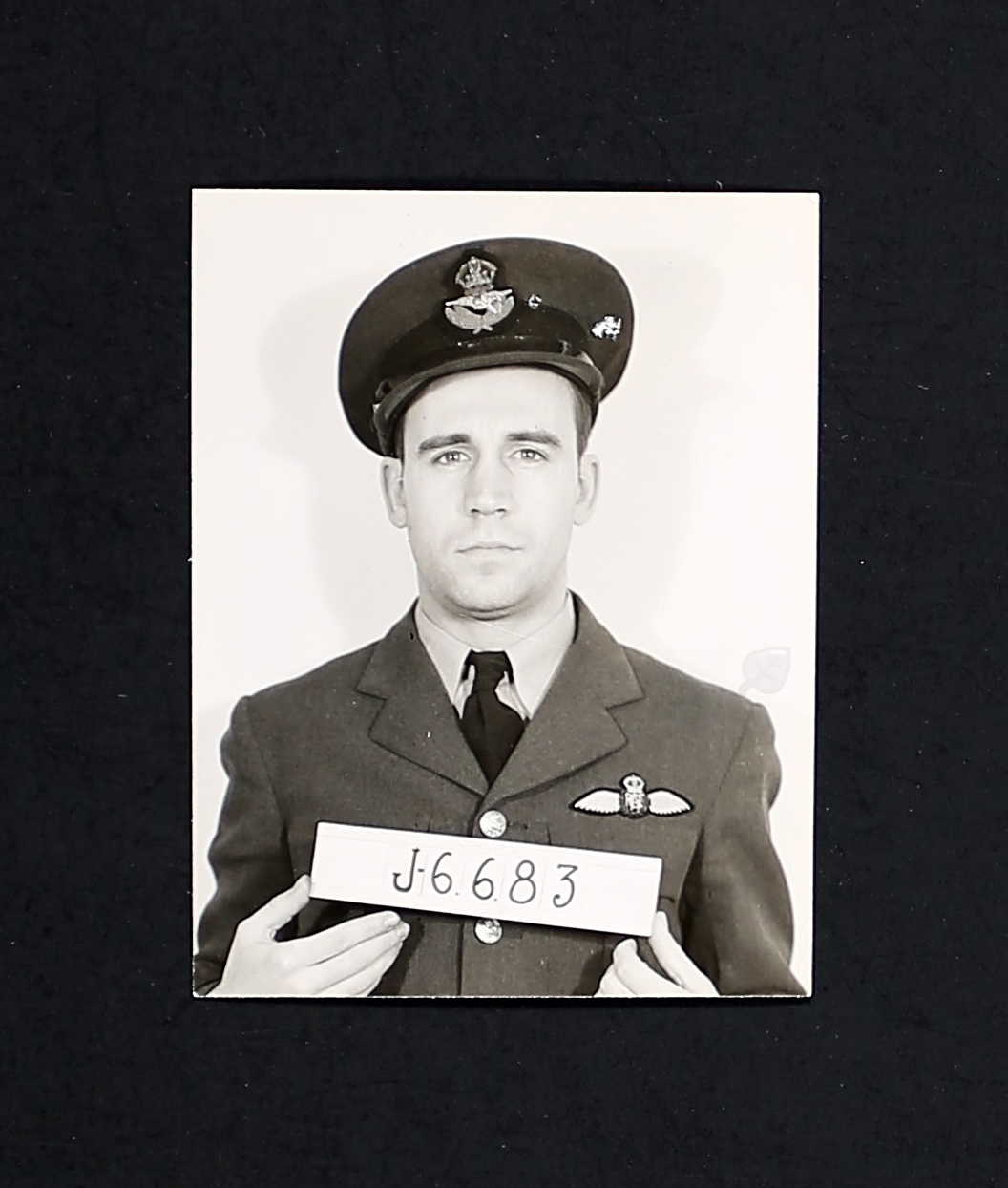
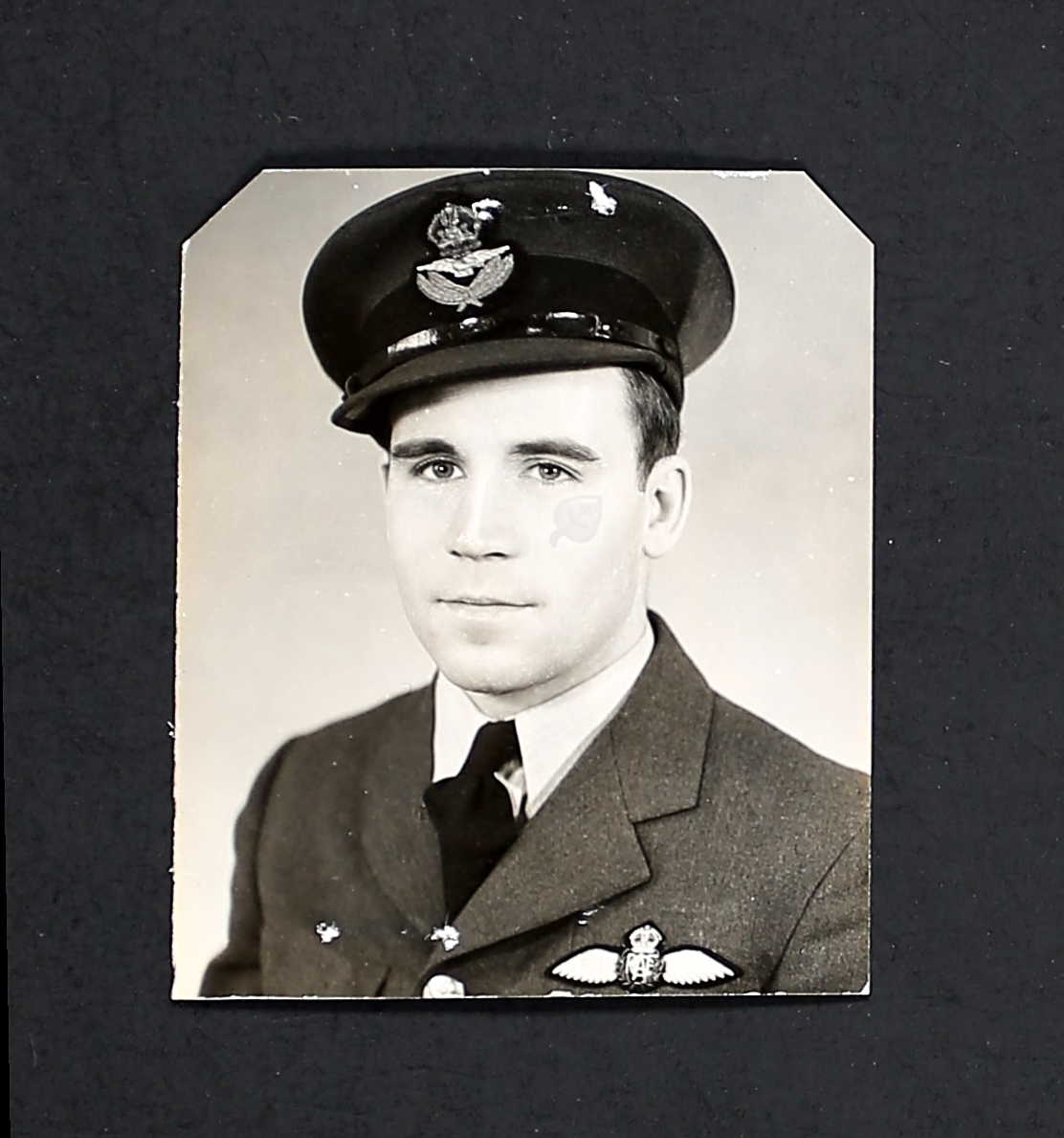
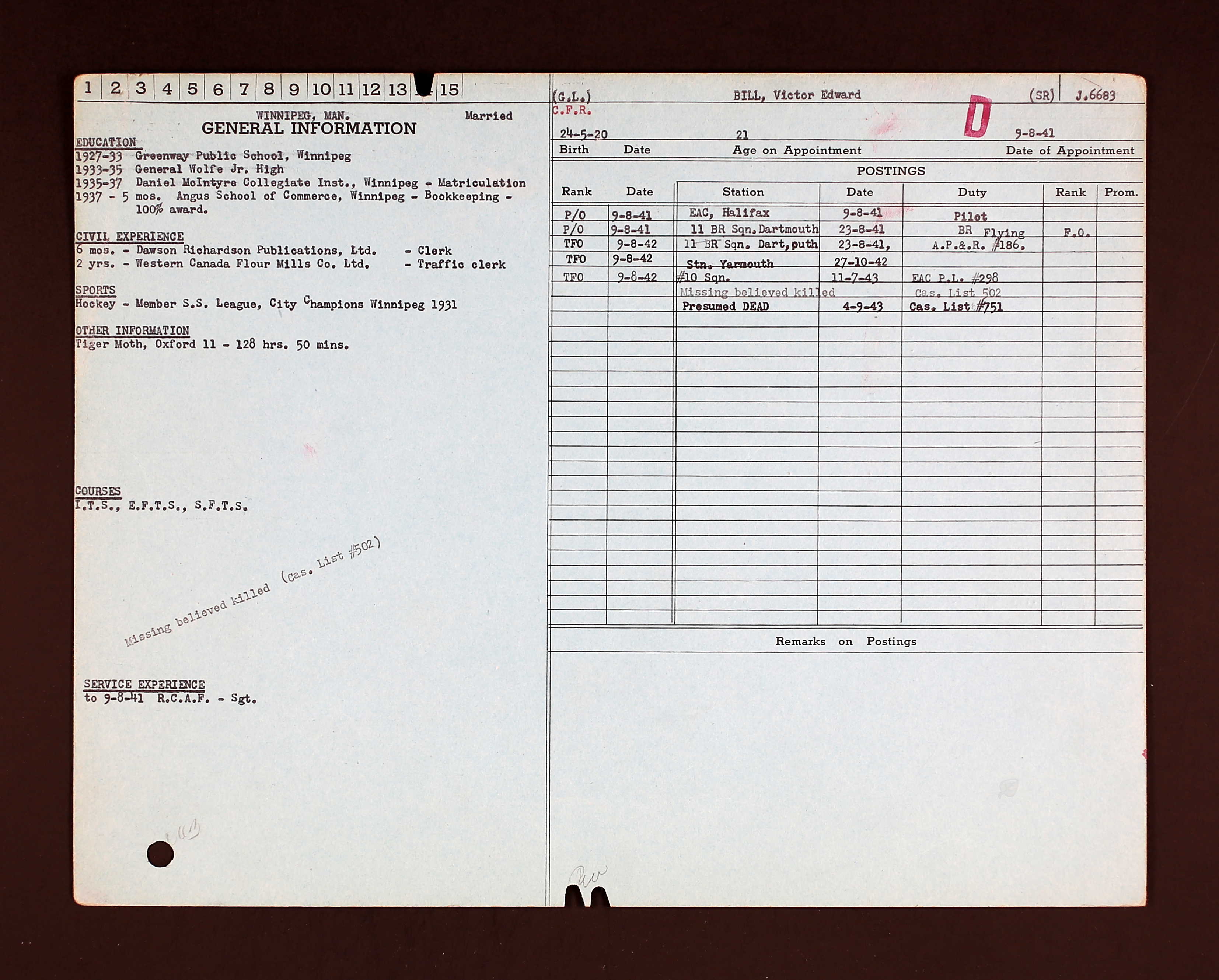
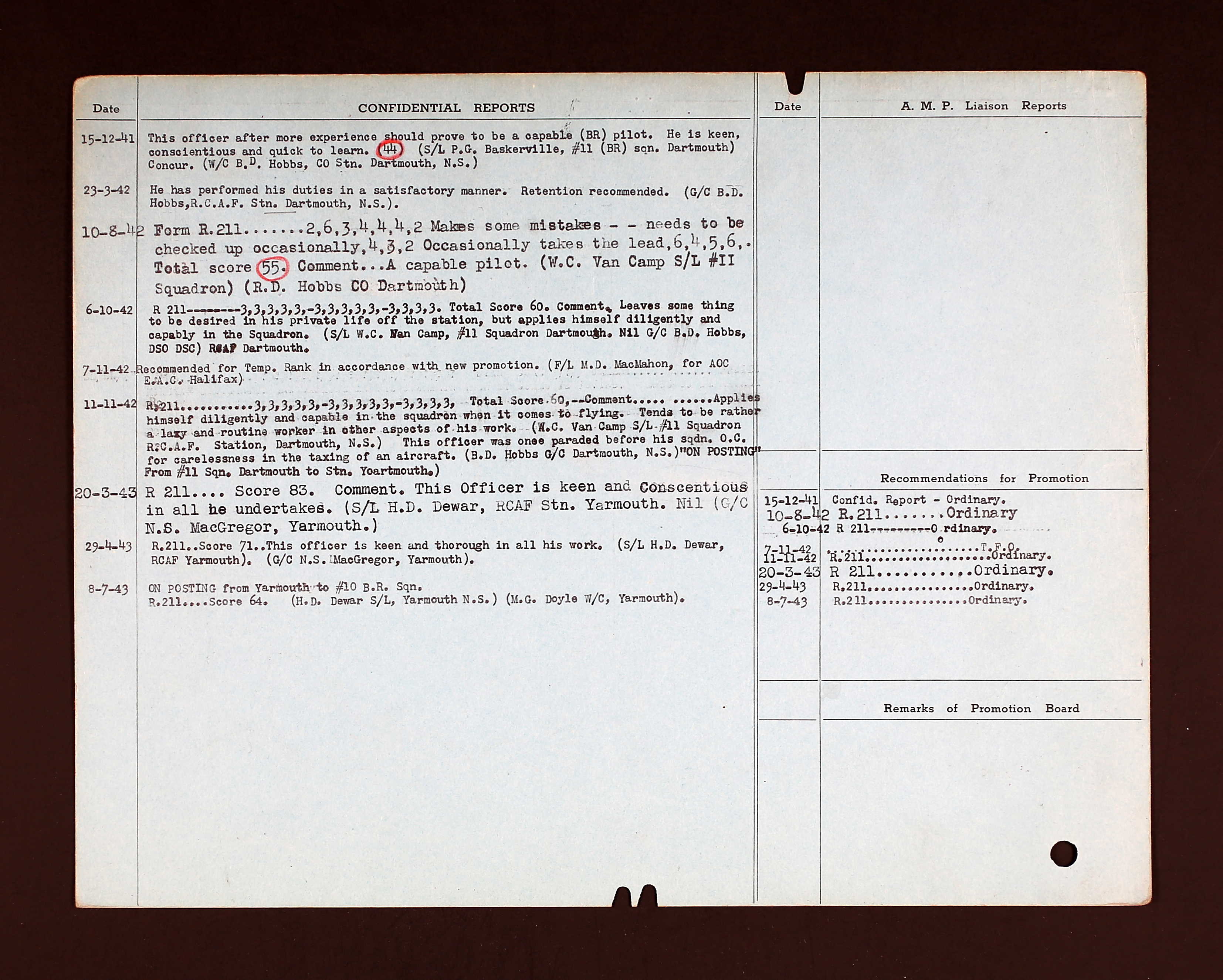
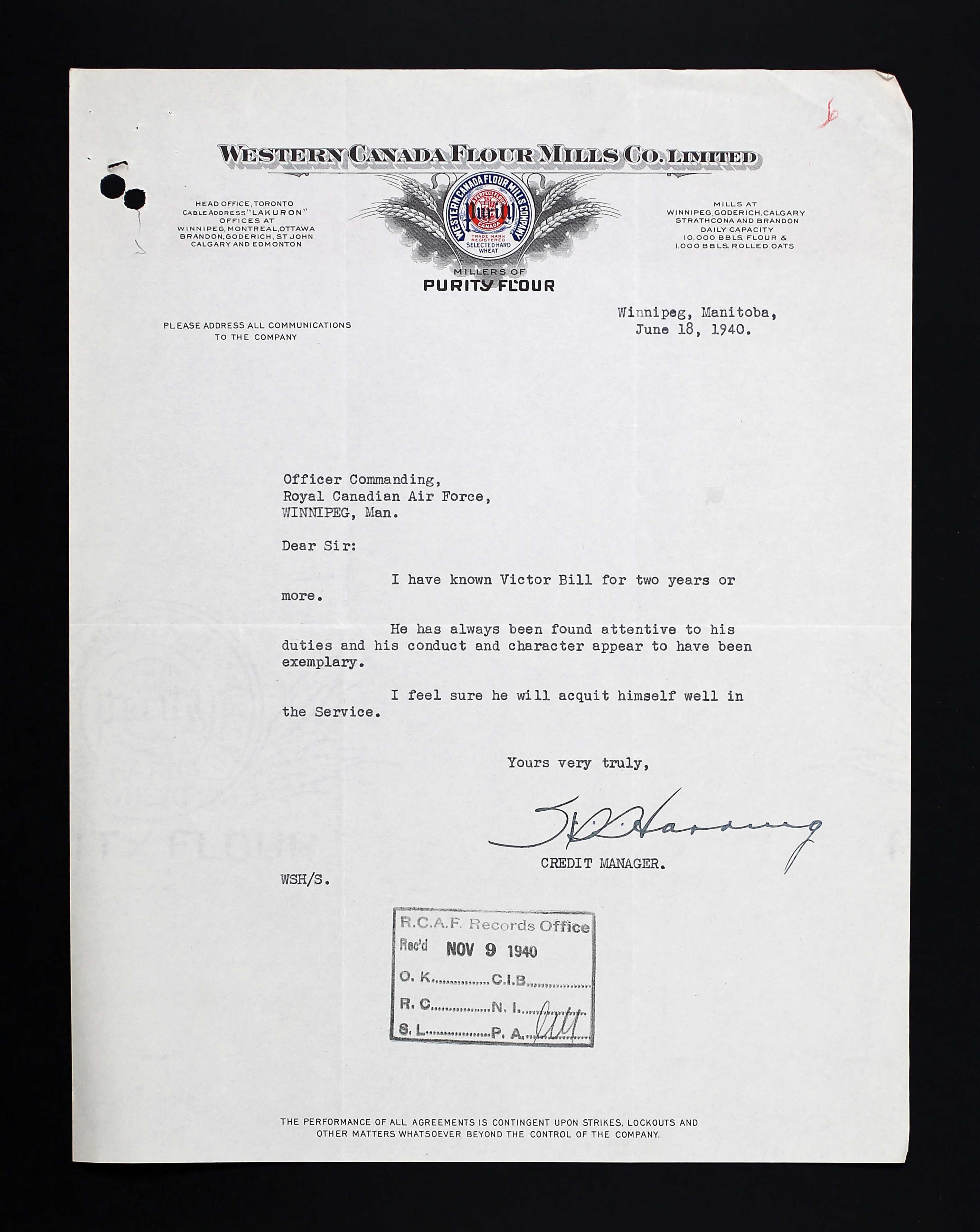

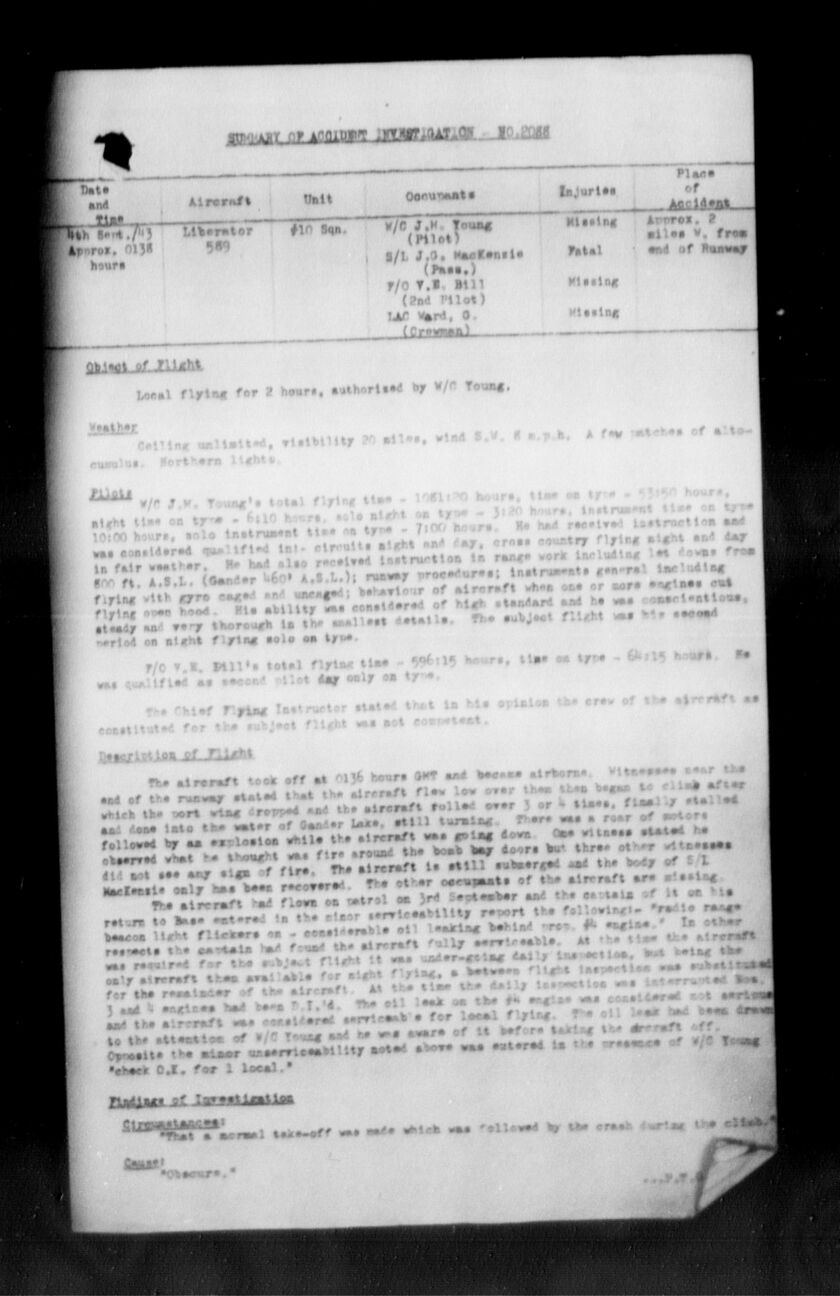
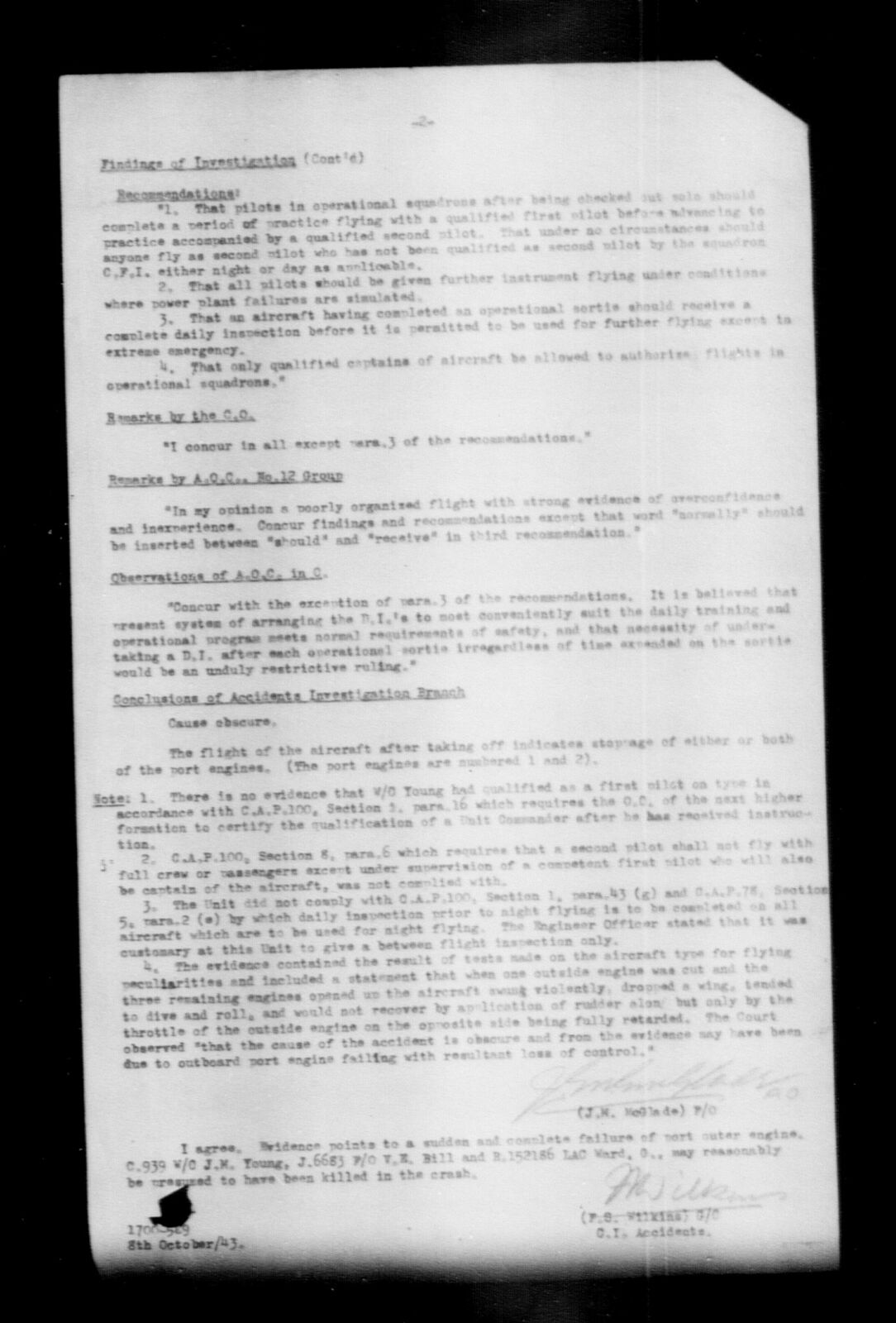

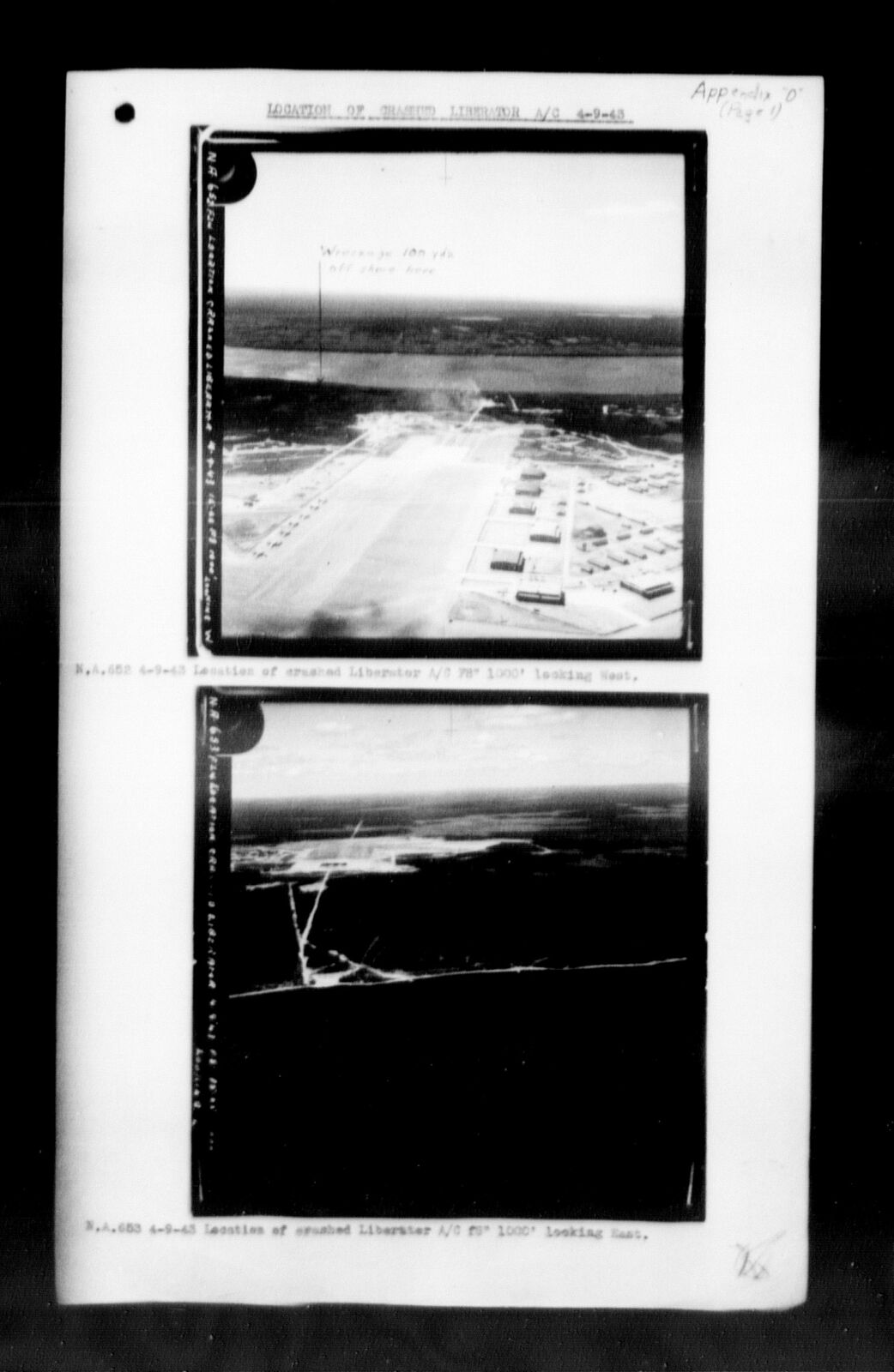
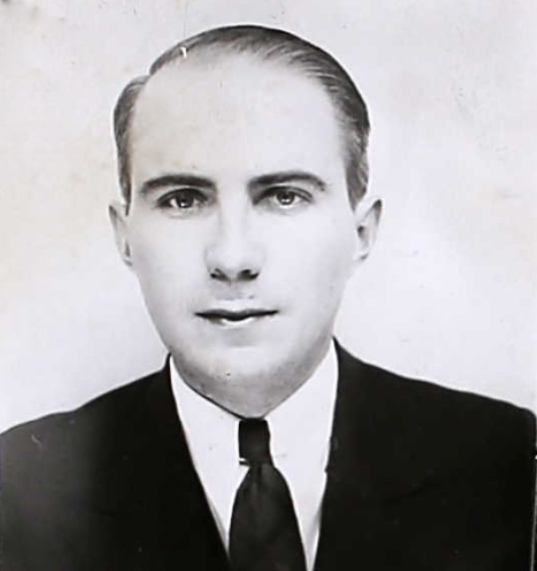
May 20, 1920 - September 4, 1943











Victor Edward Bill was the son of Thomas Bill (1879-1947), collection clerk, and Isabella (nee Gray) Bill (1882-1959) of Winnipeg, Manitoba. He had one brother, Robert Thomas Bill, 426 (Thunderbird) Squadron. The family attended the United Church.
He enlisted with the RCAF in Winnipeg on November 3, 1940. He had been working for Western Canada Flour Mills Co. Ltd as an office clerk in the traffic department prior. He noted, “I have recently passed examinations for Grad I Civil Servant (Dominion.)” He hoped to remain in the RCAF or aviation after the war. “Clean, quick, alert, straight standing. Quite personable for his age and experience. Officer calibre.”
He smoked 15 cigarettes per day and indicated he drank very little alcohol. He did not list any hobbies and sports: track and baseball. In his medical examination, he was considered to be muscular and had a standard mentality. He stood 5’ 8 ½” tall and weighed 151 pounds. He had hazel eyes and dark brown hair, with a fair complexion. He fractured his nose when he was five years old but had no complications. “Faint systolic murmur disappears on exercise.”
Victor married Winnifred Daphne McKinnon on August 14, 1941 in their hometown of Winnipeg. She later resided in Halifax, Nova Scotia, then Toronto. Victor’s brother, Robert, was the best man.
Victor had $1000 in life insurance, made payable to his mother.
He began his journey through the BCATP on November 4, 1940 at No. 2 Manning Depot, Brandon, Manitoba. Here, he had bronchitis.
He was then sent to No. 36 SFTS, Swift Current, Saskatchewan December 7, 1940 until February 1941.
Victor found himself in Regina at No. 2 ITS February 20 until March 29, 1941. “82%. 46th out of 153 in class. Average material. Former billing clerk. Energetic. Confident. Reliable. Moderate in sports. One brother in RCAF.”
He remained in Regina attending No. 15 EFTS starting March 30, 1941. “FLYING TRAINING: Final test: 70%. High average. Aggressive. Capable pilot. Alert mind. GROUND TRAINING: 76.7%. 10th out of 28 in class. Conduct exemplary. Quiet and sincere. Good self discipline.” “Inclined to overcrowd the field. Aerobatics poor. General flying above average.”
He was sent to No. 34 SFTS, Medicine Hat, Alberta May 29 until August 9, 1941. He earned his Pilot’s Flying Badge. “FLYING TRAINING: Above average. Keen, capable, shows determination, tenacious qualities. IF and Night Flying especially good. GROUND TRAINING: Average. A smart looking cadet of average ability. He is quiet and well conducted and should make a good leader of men. ARMAMENT: average.” Victor was average in formation flying and navigational ability. He was recommended for heavy bomber. “Good average. Achieved good results and will make a good bomber pilot.”
Eastern Air Command and No. 11 Squadron in Dartmouth, Nova Scotia was his posting on August 10, 1941. He was in the station hospital from August 13 – 24, 1942.
Victor was then sent to RCAF Station, Yarmouth, NS October 28, 1942, then found himself in Gander, Newfoundland later.
F/O Bill was the second pilot when he went missing aboard Liberator 589 on September 4, 1943. “Flying accident (about 150 yards offshore north side of Gander Lake, about one mile south west of west end of runway.” Others on board were W/C J. W. Young, Pilot, S/L John Grant MacKenzie, passenger (medical researcher observer), and LAC G. Ward, crewman. S/L MacKenzie’s body was recovered. [“S/L MacKenzie had reported on temporary duty to RCAF Station, Gander, to investigate the deafness in aircrew. He intended to fly various types of aircraft, investigating the amount of noise in different positions in the plane, his idea being to correlate the positions of men in aircrew with their hearing loss. On this particular flight in Liberator 589, he was carrying out this investigation.” Medical Officer F/L Melrose Keir MacGougan, (1909-2003) C14798]. S/L MacKenzie’s injuries included mandibular fracture, multiple rib fractures, fractured right humerus, dislocated left patella, multiple facial lacerations, possible skull fracture causing instant mortality. PHOTO IS LAST IN COLLECTION ABOVE.
“Liberator 589 is under 138 feet of water on the bottom of Gander Lake. The body of Squadron Leader MacKenzie has been recovered from the wreckage by Royal Canadian Navy divers. That from the divers’ descriptions of the wreckage, the aircraft is very seriously damaged. Salvage of the wreckage will be extremely difficult.”
A Court of Inquiry was struck. Seventeen witnesses were called.
OBJECT OF FLIGHT: Local flying for two hours, authorized by W/C Young. WEATHER: Ceiling unlimited, visibility 20 miles, wind SW, 8 mph. A few patches of altocumulus. Northern lights.
PILOTS: W/C Young’s total flying time: 1081 hours. Time on type: 50:30 hours. Night time on type: 6:10 hours. Solo night on type: 3:20 hours. Instrument time on type: 10 hours. Solo instrument on type: 7 hours. He had received instruction and was considered qualified in circuits night and day, cross-country flying night and day in fair weather. He had also received instruction in range work including let downs from 800 feet, runway procedures, instruments general, including flying with gyro caged and uncaged, behavior of aircraft when one or more engines cut flying open hood. His ability was considered of high standard and he was conscientious, and very thorough in the smallest details. The subject flight was his second. On night flying solo on this type. F/O Bill’s total flying time: 596:15 hours; time on type: 64.15 hours. Qualified as second pilot day only on type. The chief flying instructor stated that in his opinion the crew of the aircraft as constituted for the subject flight was not competent.
DESCRIPTION OF FLIGHT: The aircraft took off at 0136 hours and became airborne. Witnesses near the end of the runway stated that the aircraft flew low over them then began to climb after which the port wing dropped and the aircraft rolled over three or four times, finally stalled and dove into the water of Gander Lake, still turning. There was a roar of motors followed by an explosion while the aircraft was going down. One witness stated he observed what he thought was fire around the bomb bay doors, but three other witnesses did not see any sign of fire. The aircraft is still submerged and the body of Squadron Leader MacKenzie only has been recovered. The other occupants of the aircraft are missing.
The aircraft had flown on patrol on September 3rd and the captain of it on his return to base entered in this minor serviceability report the following: radio range beacon light flickers on, can still oil leakage behind prop #4 engine. In other respects, the captain had found the aircraft fully serviceable. At that time, the aircraft was repaired for the subject flight it was undergoing T inspection but being the only aircraft than available for night flying, between flight inspection was substituted for the remainder of the aircraft. At the time the daily inspection was interrupted, numbers three and four engines had been D. I. The oil leak on the 4th engine was considered not serious and the aircraft was considered serviceable for local flying. The oil leak had been drawn to the attention of Wing Commander young and he was aware of it before taking the aircraft off. Opposite the minor unserviceability noted above was entered in the presence of Wing Commander Young: “check OK for one local.”
FINDINGS OF INVESTIGATION: That a normal takeoff was made which was followed by the crash during the climb. Cause: obscure.
RECOMMENDATIONS: 1. That pilots in operational squadrons after being checked out solo should complete a period of practice flying with a qualified first pilot before advancing to practice accompanied by a qualified second pilot. That under no circumstances should anyone fly a second pilot who has not been qualified as second pilot by the squadron CFI either night or day as applicable. 2. That all pilots should be given further instrument flying under conditions where powerplant failures are simulated. 3. That an aircraft having completed an operational sortie should a complete daily inspection before it is permitted to be used for further flying except in extreme emergency. 4. That only qualified captains of aircraft be allowed to authorize flights in operational squadrons.
REMARKS BY THE CO: “I concur in all except paragraph three of the recommendations.” REMARKS BY AOC, No. 12 Group: “In my opinion a poorly organized flight with strong evidence of overconfidence and inexperience. Concur findings and recommendations except that word normally should be inserted between should and receive in 3rd recommendation.” OBSERVATIOINS OF AOC in C: “Concur with the exception of paragraph three of the recommendations. It is believed that the present system of arranging the D. I. To most conveniently suit the daily training and operational program meets normal requirements of safety, and that necessity of undertaking a D. I. After each operational sortie, irregardless of time extended on the sortie would be an unduly restrictive ruling.”
CONCLUSIONS OF AIB: Cause obscure. The flight of the aircraft after taking off indicates stoppage of either or both of the port engine. Note: 1. There is no evidence that Wing Commander Young had qualified as a first pilot on type which requires the approval of the next tier formation to certify the qualification of a unit commander after he has received instruction. 2. The second pilot shall not fly with a full crew or passengers except under supervision of a competent first pilot who will also be captain of the aircraft. This was not complied with. 3. The unit did not comply with daily inspections prior to night flying which is to be completed on all aircraft which are to be used for night flying. The engineer officer stated that it was customary at this unit to given between flight inspection only. 4. The evidence contained the result of tests made on the aircraft type for flying peculiarities and included a statement that when one outside engine was cut and the three remaining engines opened up, the aircraft swung violently, dropped a wing, tended to dive and roll, and would not recover by application of rudder alone, but only by the throttle of the outside engine on the opposite side being fully retarded. The court observed that the cause of the accident is obscure and from the evidence may have been due to outboard port engine failing with resultant loss of control.
G/C F. S. Wilkins, Accident Investigation Branch noted in a memo October 13, 1943: “the evidence in this investigation is not entirely satisfactory but for what it is worth, in my opinion, the accident was due to sudden and complete failure of the port outer engine inducing a rolling motion to the aircraft which the pilot failed to correct by shutting down the other outer engine.” He asked about the efficiency of the system of inspection in the squadron.
On October 20, 1943, he wrote: “On the balance, I think the accident was really due to the lack of experience of the crew, but there are accusations concerning maintenance which might be cleared up.”
In late June 1944, Winnifred, still residing in Halifax, received a letter informing her that Victor was, for official purposes, presumed to have died on Active Service Overseas.
In early January 1956, she received a letter, while living in Toronto, informing her that since Victor had no known grave, her husband’s name would appear on the Ottawa Memorial.
LINKS: